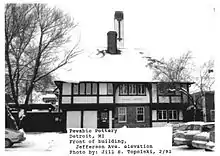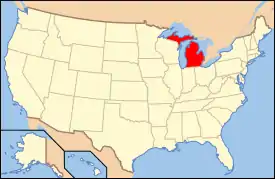Pewabic Pottery
Pewabic Pottery is a ceramic studio and school at 10125 East Jefferson Avenue, Detroit, Michigan. Founded in 1903, the studio is known for its iridescent glazes, some of which grace notable buildings such as the Shedd Aquarium and Basilica of the National Shrine of the Immaculate Conception. The pottery continues in operation today, and was designated a National Historic Landmark in 1991.
Pewabic Pottery | |
 | |
| Location | 10125 East Jefferson Avenue Detroit, Michigan |
|---|---|
| Coordinates | 42°21′40.92″N 82°58′54.02″W |
| Area | less than one acre |
| Built | 1908 |
| Architect | William B. Stratton; Baldwin, Frank D. |
| Architectural style | Tudor Revival, Kentish Inn |
| NRHP reference No. | 71000430[1] |
| Significant dates | |
| Added to NRHP | September 3, 1971 |
| Designated NHL | December 4, 1991[2] |
| Designated MSHS | December 11, 1970 |
Origin and history
The pottery was founded in 1903 by the artist and teacher Mary Chase Perry Stratton and Horace James Caulkins, her business partner.[3] Caulkins was considered a high-heat and kiln specialist, and developed the "Revelation kiln". Mary Perry Stratton was "the artistic and marketing force."[4] The collaboration of two and their blend of art and technology gave the pottery its distinctive qualities as Detroit's contribution to the International Arts and Crafts movement and exemplified the American Craftsman Style.[5]
The word Pewabic is derived from the Ojibwa (or Chippewa) word "wabic", which means metal, or "bewabic", which means iron or steel, and specifically referring to the "Pewabic" Upper Peninsula copper mine where Ms. Stratton walked with her father. The company is well known for the unusual iridescent glaze covering the pottery and tiles created in a manner outlined by the International Arts and Crafts movement.[6][7][8]
In 1991, Pewabic Pottery was designated as a National Historic Landmark (see also List of National Historic Landmarks in Michigan). As Michigan's only historic pottery, the center continues to operate in a 1907 Tudor Revival building as a non-profit educational institution. They offer classes in ceramics, hold exhibitions, sell pottery made in house, showcase and sell artists from across the United States, and offer design and fabrication services for public and private buildings.
Museum and galleries
The museum's exhibits focus on the company's role in the history of Detroit, the Arts and Crafts movement in America and the development of ceramic art in the country. The galleries also showcase new works by modern ceramic artists.
Famous works
Pewabic Pottery produces many kinds of hand made decorative objects. They are part of the collections of the Detroit Institute of Arts, the University of Michigan Museum of Art, and the Freer Gallery of Art.[9][10][6]
Under Mary Stratton's artistic leadership, Pewabic Pottery employees created lamps, vessels, and architectural tiles. Architectural pieces have been a staple in Pewabic's history. They were known for their iridescent (like an oil slick with an incredible translucent quality and a phantasmagoric depth of color) glazes. Architectural tiles were used in churches, concert halls, fountains, libraries, museums, schools and public buildings. The studio's work graces numerous edifices throughout Michigan and the rest of the United States. Noteworthy examples include Herzstein Hall at Rice University in Houston, Texas,[11][12] and the Shedd Aquarium in Chicago. Illinois.[9] Detailed maps of public installations in the Detroit Metropolitan Area and the U.S.A. are available.[13] See Architectural tile infra.
Particularly notable was the company's work at the Basilica of the National Shrine of the Immaculate Conception in Washington, D.C., consisting of arches outlined with iridescent Pewabic tile, huge ceramic medallions set in the ceiling, and fourteen Stations of the Cross for the crypt.[6]
Pewabic's design team continues to create ornate tile conceptions for public and private buildings. Contemporary installations include Comerica Park, home of the Detroit Tigers, Detroit Medical Center Children's Hospital, five Detroit People Mover stations, Third Man Records (Detroit), stations for the Q-Line, and the Herald Square in New York City.
Architectural tile

.jpg.webp)
Pewabic tile was (and continues to be) in great demand in Detroit and the southeastern Michigan area for the use in buildings and it can be found in many of the area's finest structures.[14] These include:
- Belle Isle Aquarium, Belle Isle Park Detroit, Michigan
- Cathedral Church of St. Paul, Detroit, Michigan[15]
- Cathedral of the Most Blessed Sacrament, Detroit, Michigan
- Charles Lang Freer House, 71 East Ferry Avenue (Current name: Palmer, Merrill, Institute of Human Development & Family Life) Detroit, Michigan[16]
- Christ Church, Cranbrook, Bloomfield Hills, Michigan
- Compuware World Headquarters, Detroit, Michigan
- Cowles House (a/k/a Alice B. Cowles house, formerly known as Faculty Row House Number 7 and presently the Michigan State University President's home), East Lansing, Michigan
- Cranbrook Kingswood School, many facilities[17]
- Detroit Institute of Arts, Detroit, Michigan (loggia)[15]
- Detroit People Mover many stations, Detroit, Michigan[18][19]
- Detroit Public Library Children's Room, Detroit, Michigan[8][15]
- Detroit Zoological Park, Royal Oak, Michigan
- Edward H. McNamara Terminal, Northwest Airlines, Detroit Metropolitan Wayne County Airport, Romulus, Michigan[11]
- English Inn (formerly Medovue Manor), Eaton Rapids, Michigan built in 1927 for Oldsmobile President Irving Jacob Reuter[20]
- Father Solanus Casey Center, Detroit, Michigan[21][22]
- Guardian Building, Detroit, Michigan.[6]
- Harper House, 1408 Cambridge Drive, Lansing, Michigan[23]
- Hill Auditorium, University of Michigan, Ann Arbor, Michigan
- Kedzie North, Michigan State University, East Lansing, Michigan
- Kirk in the Hills, Bloomfield Hills, Michigan
- Lawrence Fisher Mansion, Detroit, Michigan[24]
- Mackenzie High School, 9275 Wyoming Avenue, Detroit, Michigan (Now at the landfill - demolished)
- Maude Priest School, Detroit, Michigan[25]
- Michigan Historical Museum, Lansing, Michigan[26]
- Michigan League, University of Michigan, Ann Arbor, Michigan[27]
- Michigan Union, University of Michigan, Ann Arbor, Michigan[27]
- Michigan State University Memorial Chapel, East Lansing, Michigan
- Michigan State University Union Women's Lounge (fireplace), East Lansing, Michigan

- Morton High School, Richmond, Indiana
- National Theater, Monroe and Farmer, Detroit, Michigan (facade, 1911)[28]
- North Kedzie Hall, Michigan State University, East Lansing, Michigan
- Oakland Family Services, Pontiac, Michigan[29]
- Sacred Heart Major Seminary, Detroit, Michigan
- Scott Fountain, Belle Isle Park, Detroit, Michigan, 1922[30]
- Shaw Hall, Michigan State University, East Lansing, Michigan
- Southfield Public Library, Southfield, Michigan
- Stephen M. Ross School of Business, University of Michigan, Ann Arbor, Michigan
- Wayne State University David Adamany Undergraduate Library, 5155 Gullen Mall Detroit, MI 48202-3962[15][31]
- Wayne State University Merrill Palmer Institute, Detroit, Michigan[15][32]
- Wayne State University, Old Main, Previously, Detroit Central High School, 4841 Cass Detroit, MI 48201[15][31]
- Women's City Club now Detroit Police Academy, Elizabeth and Park, Detroit, Michigan
See also
| Wikimedia Commons has media related to Pewabic Pottery. |
References
Notes
- "National Register Information System". National Register of Historic Places. National Park Service. January 23, 2007.
- "Pewabic Pottery". National Historic Landmark summary listing. National Park Service. Archived from the original on 2012-10-06. Retrieved 2008-06-27.
- "National Park Service designation of Pewabic Pottery as National Historic Landmark".
- "Historian chronicles historic pottery".
- "Brunk, Thomas W., Ph.D., Curator on Pewabic Pottery history and exhibit at Marshall Fredericks Museum". Archived from the original on 2010-05-30. Retrieved 2007-12-04.
- Nolan, Jenny (2000-02-12). "Pewabic tile, Detroit's art treasure". Detroit News.
- "Painting With Fire: Pewabic Vessels in the Margaret Watson Parker Collection (University of Michigan Art Museum)". Archived from the original on 2007-07-13. Retrieved 2007-11-12.
- "Child's history of Pewabic Pottery and Mary Stratton--Michigan Historical Museum" (PDF).
- "Craft in America, Mary Chase Perry Stratton".
- "Exchange|Search: artist:"Pewabic Pottery"". exchange.umma.umich.edu. Retrieved 2020-12-09.
- "Commentary on Pewabic Pottery".
- "The Perils of Planning...Or Not" (PDF). Archived from the original (PDF) on 2012-07-25. Retrieved 2015-05-04.
- "See, maps and detailed lists of U.S. and Detroit metropolitan area architectural installations of Pewabic Pottery, Pewabic Pottery home page". Archived from the original on 2007-11-11. Retrieved 2007-11-14.
- "Maps and detailed lists of U.S. and Detroit metropolitan area architectural installations of Pewabic Pottery, Pewabic Pottery home page". Archived from the original on 2007-11-11. Retrieved 2007-11-14.
- "Map and list of Detroit cultural center installations". Archived from the original on 2007-11-12. Retrieved 2007-11-29.
- "City of Detroit Planning and Development Department on Charles Lang Freer house" (PDF). Archived from the original (PDF) on 2011-07-18. Retrieved 2010-05-13.
- "Map and list of Cranbrook area installations". Archived from the original on 2007-11-12. Retrieved 2007-11-29.
- "Map and list of People Mover architectural installations". Archived from the original on 2007-11-12. Retrieved 2007-11-29.
- "Picture of People Mover Station, Pewabic Pottery home page". Archived from the original on 2007-12-11. Retrieved 2007-11-28.
- "English Inn history page".
- "Solanus Casey Center home page".
- "Picture of Solanus Casey installation, Pewabic Pottery home page". Archived from the original on 2007-12-11. Retrieved 2007-11-28.
- "Harper House description".
- "Bhaktivedanta Cultural Center".
- "Picture Maude Priest School, Pewabic Pottery home page". Archived from the original on 2007-12-11. Retrieved 2007-11-28.
- See
- "Historian chronicles story of Pewabic Pottery".
- "List and map of Detroit Metro area installations". Archived from the original on 2007-11-12. Retrieved 2007-11-29.
- "Picture, Oakland Family Services donor wall, Pewabic Pottery home page". Archived from the original on 2007-09-18. Retrieved 2007-11-15.
- "List and maps of Detroit metro installations". Archived from the original on 2007-11-12. Retrieved 2007-11-29.
- "Picture, David Adamany Library installation Pewabic Pottery home page". Archived from the original on 2007-12-11. Retrieved 2007-11-28.
- "Picture, wall murat at Merrill Palmer Institute, Pewabic Pottery home page". Archived from the original on 2007-09-18. Retrieved 2007-11-15.
Sources
- Barrie, Dennis; Jeanie Huntley Bentley; Cynthia Newman Helms; Mary Chris Rospond, Artists in Michigan: 1900-1976. (Wayne State University Press, Detroit 1989). ISBN 0-8143-1907-6.
- Brunk, Thomas W. "Ceramics in Michigan, 1886-1906" in The Arts and Crafts Movement in Michigan: 1886-1906. (Detroit, The Pewabic Society, Inc., 1986). ISBN 0-937885-00-2
- Brunk, Colby, Jacobs et al., Arts and Crafts in Detroit 1906-1976: The Movement, The Society, The School. (Detroit Institute of Arts, Detroit MI 1976).
- Brunk, Thomas W., with Introduction by Marilyn L. Wheaton, Marshall Fredericks Sculpture Museum Exhibition Catalog, June 1 through September 29, 2007, Essay on Pewabic Pottery.[1][2]
- Colby, Joy Hakanson, Art and a City: A History of the Detroit Society of Arts and Crafts. (Wayne State University Press, Detroit MI, 1956). ISBN 0-686-87987-2.
- Fisher, Marcy Heller and illustrated by Marjorie Hecht Simon, Fired Magic: Detroit's Pewabic Pottery Treasure. (Wayne State University Press, 2003). ISBN 0-8143-3143-2.
- Gibson, Arthur Hopkin, Artists of Early Michigan: A Biographical Dictionary of Artists Native to or Active in Michigan, 1701-1900. Wayne State University Press, Detroit, 1975. ISBN 0-8143-1528-3.
- Hill, Eric J., and John Gallagher, AIA Detroit: The American Institute of Architects Guide to Architecture in Detroit. (Wayne State University Press, Detroit, MI 2003). ISBN 0-8143-3120-3.
- Karlson, Norman, The Encyclopedia of American Art Tiles, Volume 2, Region 3: Midwestern States. (Schiffer Publishing Ltd., 2005). ISBN 0-7643-2231-1 ISBN 978-0764322310.
- Pear, Lillian Myers, The Pewabic Pottery: A History of its Products and its People. (Des Moines, Iowa, Wallace-Homestead: 1976). ISBN 0-87069-158-9.
- Rago, David, Suzanne Sliker, and David Rudd, The Arts & Crafts Collector's Guide. (Salt Lake City, Utah, Gibbs Smith, 2005). ISBN 1-58685-052-0.
- Savage, Rebecca Binno and Greg Kowalski. Art Deco in Detroit (Images of America). (Arcadia, 2004). ISBN 0-7385-3228-2.
External links
- Pewabic Pottery - official site
- Child's history of Pewabic Pottery and Mary Stratton--Michigan Historical Museum
- Pewabic page at Craft in America
- Marshall Fredericks Sculpture Museum Exhibition Catalog, June 1 through September 29, 2007, Essay on Pewabic Pottery, its importance, and the partnership between Caulkins and Stratton (Archive August, 2007)
- Pewabic Pottery Virtual Tour
- "Product page for Exhibition Catalogue".
- "Brunk, Thomas W., Ph.D., Curator on Pewabic Pottery history and exhibit at Marshall Fredericks Museum". Archived from the original on 2012-02-15. Retrieved 2018-09-04.

.svg.png.webp)


